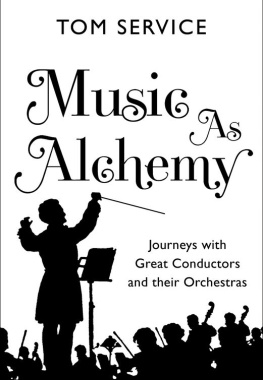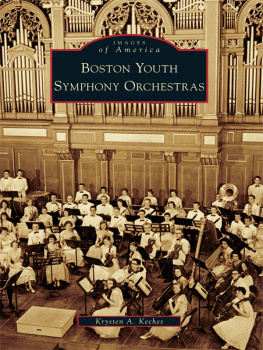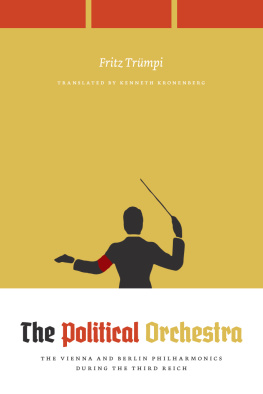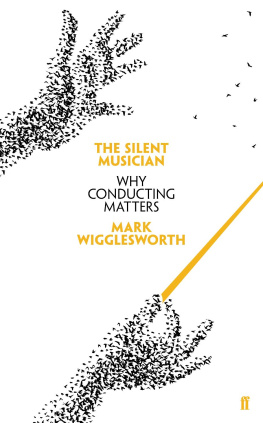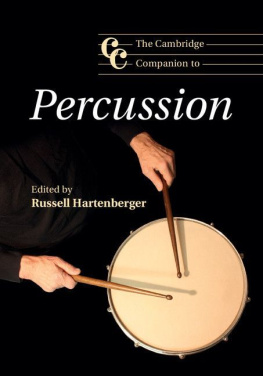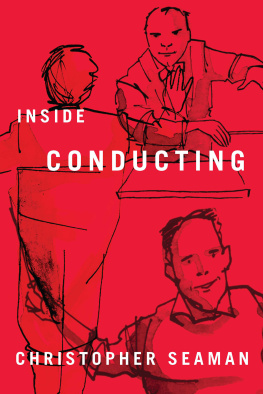It seemed like magic then, and it still does. The first orchestral concert I ever saw was in the lino-clad glory of Glasgows City Hall when I was seven, in 1983. I had expressed no desire to see an orchestra play: I had just started to make my first faltering fingerings through beginners piano books, and only went along because a friend of the family was ill and there was a spare ticket. But what happened after the Scottish Chamber Orchestra assembled on stage, about six feet above my seat near the front of the stalls, would change my life. I craned my neck and saw a very young-looking Richard Hickox step on to the concert platform, after the musicians had made some weird, tuneless scratchings and scrapings. There was some applause for Hickox, though he didnt seem to have an instrument anywhere underneath his tails, so why everyone thought he was so special was beyond me. He stood in front of the players, he made a couple of arcane signs in the air with what looked like a magicians wand, and the music started. And something opened up in me, some place of resonance and meaning, which Ive been exploring ever since.
The music was the main thing. I found out that it was by Mozart, his Symphony No. 29 in A major, K201 (all part of the trainspottery information I quickly started to imbibe as a new and zealous convert), and I was unstoppable in my quest to hear more, discover more. It was Mozarts symphonies, concertos, sonatas, and operas I threw myself into first, my early Walkman devouring tapes on long car journeys until they wore out (and the Walkmen too, over the years): Herbert von Karajan conducting the Berlin Philharmonic Orchestra, Daniel Barenboim with the English Chamber Orchestra, Karl Bhm with the Berlin Philharmonic again (that orchestra seemed to be everywhere, especially on a record label that styled itself with big yellow stickers, and the Berliners quickly became one of my favourites). Then there was Neville Marriner with the glamorously named Academy of St Martin in the Fields, Leonard Bernstein with the Vienna Philharmonic (a close second to the Berlin Phil in my affections), Otto Klemperer with the New Philharmonia (there was obviously an Old Philharmonia I had never heard of ), the extravagantly mustachioed Arturo Toscanini with the NBC Orchestra, John Eliot Gardiner and the English Baroque Soloists, and the charismatic Nikolaus Harnoncourt with his wild staring eyes and the Chamber Orchestra of Europe. I gorged myself on all of them and more playing Mozart, Bruckner, Beethoven, Mahler, Brahms, Schoenberg, Stravinsky, Bach, Elgar, Scriabin, Ligeti, James MacMillan, Joonas Kokkonen: anything I could get my hands on, and everything I heard and liked on BBC Radio 3.
But there was something else, too. I didnt hear this canon of orchestral music as monuments of sound, great things that one really ought to know about, to be worshipped and adored from a safe distance. To me, all the pieces of music I loved were visceral experiences that did things to my insides, to my brain and body, things I still cant fully explain, because of the way they moved through and manipulated time.
And when I started going to more concerts, the person who seemed to be at the centre of this flow of time, both moving with it and apparently shaping it, was the person usually a man who stood where Richard Hickox had taken his place: in the centre of the podium at the front of the City Hall, almost always using nothing more than a white stick, and making no sound at all, bar the odd expressive grunt. The conductor wasnt the composer but he seemed to be the closest person to the source of the music, wherever that was, since without conductors, most orchestral performances would never get started. The conductors I saw most often in concert, like Walter Weller, Bryden Thomson, and Neeme Jrvi, with the Scottish National Orchestra (now Royal Scottish National Orchestra), were the ones responsible for the music happening, for creating and shaping the time-flow of the music.
That was what I wanted to do. At home, my impressions of Toscanini and Karajan in their pomp were legendary. At least, they were to me and my mute audience of tapes, CDs, and music dictionaries. That was before I had even seen film of either of them conducting: but leading the Berlin Philharmonic or the NBC Symphony in my window (which, I admit, acted like a mirror after dark), I felt the music flow through me as I thought it must flow through them.
And I still do it, after teenage years of conducting courses and forcing myself on unsuspecting orchestras, choirs, and contemporary music ensembles at university and afterwards. Even knowing a bit about the technique of conducting hasnt dimmed my appalling habit of sitting in concert halls listening to the worlds great orchestras and conductors and giving an involuntary downbeat at the start of a Beethoven scherzo, or showing the oboist how to shape that melody in the slow movement of Brahmss Violin Concerto.
But my ideal was: be Simon Rattle or bust. I quickly discovered the shocking truth that there is, in fact, more to conducting than moving your arms in time with the music, or emoting along to your favourite Bruckner or Mahler symphonies. My skills as a performer were never good enough to equip me for the traditional routes into conducting becoming a pianist at an opera house and being given the chance to pick up a baton, or playing in an orchestra and learning how others do it before moving to the podium and so my dreams of conducting the Berlin Philharmonic remain unrealised.
Yet my fascination with conducting has never dimmed, and thats what this book is about. In part, its an attempt to answer the simplest question of all: what is it that conductors do up there? How can a person who makes no sound occupy the attention of more than a hundred musicians who really do make a sound and of the audience, too? But the book also deals with a bigger question, exploring what that hackneyed old phrase, the art of the conductor, might actually mean. If conducting is about anything, its about communication. Its significant real-time interaction between one person and a larger group of musicians. Far from being mystical, conducting is about things that happen and which can be described. Something is passed from the conductor to the orchestra, and vice versa, and its the quality and intensity of that communication that is responsible for what happens in orchestral performance.
Its been a centuries-long cultural development to get to this point. The roots of conducting in the sense we understand it today a person with a stick controlling the musical impulse of serried ranks of musicians playing instruments go back to the seventeenth century, but the basic idea of someone commanding a large group of singers or players goes back much further. Theres a report from Greece in 709 BC of a group of eight hundred musicians being led by on Pherekydes of Patrae, giver of Rhythm, who waved a golden staff so that the men began in one and the same time [beating] his stave up and down in equal movements so that all might keep together. The Greeks also gave us the idea of cheironomy, a system of moving the hands to indicate pitch level and melodic contour to singers, something employed in India, China, Egypt, and Israel; and in the first millennium AD there were traditions of Jewish Torah-singing which used the right hand to signal different melodic formulae. In modern times, the first evidence of a baton being used comes with the nuns of St Vita in 1594: Finally the Maestra of the concert sits down at one end of the table and with a long, slender and well-polished wand gives them without noise several signs to begin, and then continues by beating the measure of the time which they must obey in singing and playing. The sort of silent baton used by the Maestra of St Vita was not generally adopted straight away, as the story of Lully shows. Jean-Baptiste Lully was the most famous composer-conductor of the seventeenth century, and hes also the most celebrated casualty of a conducting accident. Lully was so important a part of Louis XIVs court that he was de facto the head of all music-making throughout France. Instead of a baton, this early musical dictator used a long staff to beat time on the floor, and while directing a Te Deum for the Sun King in 1687, he stabbed his toe. The injury developed into an abscess, became gangrenous, and killed him two months later. Many have suffered for the art of conducting, but only a few, like Lully, have died from an injury sustained in the act.

